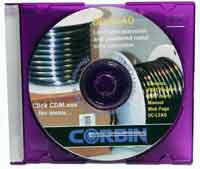|
|
|
Lead Extrusion/Powder Metals
|
| |

|
Quantity in Basket:
None
Catalog No.: DC-LEAD
Price: $12.00
Shipping Weight: 0.10 pounds
Sorry, we are no longer taking orders for the Lead Extrusion/Powder Metals on our legacy website. Please visit our new website at Corbins.com for all future orders. Any question/concerns you can reach us at sales@corbins.com Thank you
|
| |
The DC-LEAD instant calculator program can be
installed on your hard disk under the DC-LEAD folder,
or it can be run from the CD-ROM directly.
The CD-ROM also contains a printable chart of lead wire
lengths for given weights, in all standard diameters. This
helps you quickly cut the proper length of wire to make a
certain weight of core for any caliber.
The purpose of the program is to calculate the length,
weight and volume of lead wire that can be extruded,
in your choice of diameters, from a given diameter of
lead billet, of a given hardness. It also estimates the
required drive pressure, given a certain diameter of
hydraulic drive cylinder to power the extruder.
A second window, accessed by clicking "Cores",
calculates the length of a given diameter lead core
to achieve a given weight using a selected material
density. It also calculates the compressed length and
effective density of powdered metal cores of a given
weight and diameter, and calculates effective density
of a mixture of given volumes of different core
materials, up to three materials.
The program provides feedback if impractical values
are entered, and self-corrects back to a reasonable
number. The screens can be printed on any
Windows-compatible printer. Density is given in
pounds per cubic inch, and displayed in grams per
cubic centimeter as well.
The extruder functions are based on certain assumptions
about the amount of friction and resistance caused by
moving the lead through a certain diameter extrusion die.
In a practical system, there are variations in
resistance due to die design, smoothness, lubrication,
and temperature. Therefore, the program provides an
adjusment factor called "lubricant efficiency" which
adjusts the amount of resistance assumed, and changes
the pressure for a given hardness and diameter of
wire extruded with a given size of cylinder from a
certain length and diameter of billet.
The normal setting for lube efficiency is "10", but it
can be set from 1 to 100 to bring the results in line
with experience from a given machine. To predict
extruder size and pressure with reasonable margin of
safety, always use the lower efficiency settings
until you know for certain that your extruder does,
in fact, allow lower pressures.
Powdered metals are usually poured into a core swage
die or jacketed bullet "cup" (the jacket itself) and
then compressed. The volume and effective density of
the core will change with compression.
The basic metal density itself will always be higher
than the effective density, since small amounts of
space exist between particles of the powder which
are not present in the solid form of the metal
(or other powder).
The program asks for the basic material density of the
solid, and then asks for the diameter of the core and
the amount of compression as a percentage of original
"as poured" volume. When you pour a powder into a die
or jacket, it "stacks up" in a long column.
Then, a punch is used to compress this column into
the jacket or die, shortening the column.
The ratio of the original column to the compressed
core length is this percentage. A core cannot be
compressed 100% because that would mean it went from
some measurable length to zero (a black hole?) and
the means to do that are beyond the normal realm of
bullet manufacturing.
A typical compression might be between 20 and 50 percent.
The core weight remains the same as the original volume
of powder, but the density is increased as the length is
decreased. The program gives you these figures.
The combination of materials, whether they be powders
or solids melted together, or simply put one after
another into a die or jacket as solid bits, results
in a net effective density which would be the same as
a single material of some type. The program lets you
calculate two or three different materials in various
ratios from 0 to 100 percent each, of different
densities, in order to show this effective density.
Zero percent means that there is none of that material,
so it is taken out of the equation completely. One
hundred percent means no other materials are present.
Anything between these two numbers gives a valid
calculation of effective density for two or three
materials in one core.
|
|
































